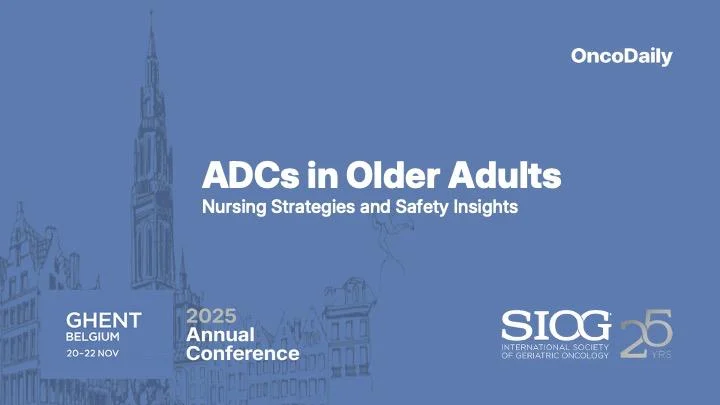Fresh from the SIOG 2025 Annual Conference, the educational session “Nursing Essentials in Antibody-Drug Conjugates (ADCs) for Older Adults with Cancer” gathered oncology nurses, nurse practitioners, clinical nurse specialists, and allied health professionals for a comprehensive exploration of ADC use in older adults. With these targeted therapies now central to modern oncology, the session highlighted the critical role nurses play in ensuring safe administration, early toxicity detection, and meaningful communication in a population with unique needs.

Cindy Kenis (Leuven, Belgium) opened the session by outlining the learning objectives and emphasizing the relevance of ADCs in geriatric oncology. As their use expands, she noted, nursing teams must understand not only the science behind these therapies but also how age-related vulnerabilities influence clinical decision-making and care delivery.
Understanding ADCs: Mechanisms, Agents, and Geriatric Considerations
In the first module, Capucine Baldini (Villejuif, France) provided a clear and accessible overview of ADCs. She explained how the combination of a monoclonal antibody, a cytotoxic payload, and a linker allows highly targeted drug delivery, reducing systemic toxicity while maximizing tumour-directed activity. Baldini reviewed commonly used ADCs in older adults and discussed how frailty, multimorbidity, and polypharmacy can influence pharmacokinetics and treatment tolerance. Her presentation emphasized that older adults are not simply “older versions” of younger patients but a clinically distinct group requiring individualized nursing strategies.
Managing Toxicities: The Nursing Lens
The second module, led by Ana Carolina Grisotto (São Paulo, Brazil), focused on the hallmark toxicities associated with ADCs and the frontline role nurses play in their management. She reviewed common challenges such as hematologic suppression, peripheral neuropathy, ocular changes, gastrointestinal effects, and infusion reactions, underscoring that early recognition remains the cornerstone of safe care. Grisotto highlighted practical elements of monitoring, symptom coaching, and caregiver engagement, reinforcing that nursing vigilance can substantially influence treatment continuity and patient well-being.
Learning Through Practice: A Case-Based Workshop
Following a short break, an interactive case-based workshop guided by Nicolò Matteo Luca Battisti (Sutton, United Kingdom), Bonnie Leung (Vancouver, Canada), and Allison Magnuson (Rochester, United States) brought the theoretical components into real-world context. Participants evaluated an older patient receiving an ADC, working through assessment approaches, monitoring strategies, toxicity mitigation, and communication with patients and their families. The discussion demonstrated how multidisciplinary thinking and geriatric principles intersect in day-to-day care. The facilitators closed the module by highlighting key nursing “red flags” that require prompt action.
Safe Handling, Administration, and Practical Takeaways
The final module, presented by Vanya Slavova-Boneva (Sutton, United Kingdom) together with Bonnie Leung, addressed the operational aspects of ADC delivery. They reviewed handling protocols, infusion preparation, personal protective equipment requirements, and appropriate disposal methods, emphasizing the importance of safety for both patients and healthcare staff. The session concluded with a summary of essential concepts, participant questions, and evaluation instructions for certification.
A Core Message for Geriatric Oncology Nursing
Across all modules, the session reinforced a consistent theme: as ADCs become increasingly integrated into cancer care, nurses are central to optimizing their use in older adults. This role blends scientific knowledge, geriatric expertise, and empathetic communication, ensuring that complex therapies can be delivered safely and effectively. The SIOG 2025 session offered an essential, practical foundation for nursing professionals navigating this rapidly evolving therapeutic landscape.
For more information click here.
